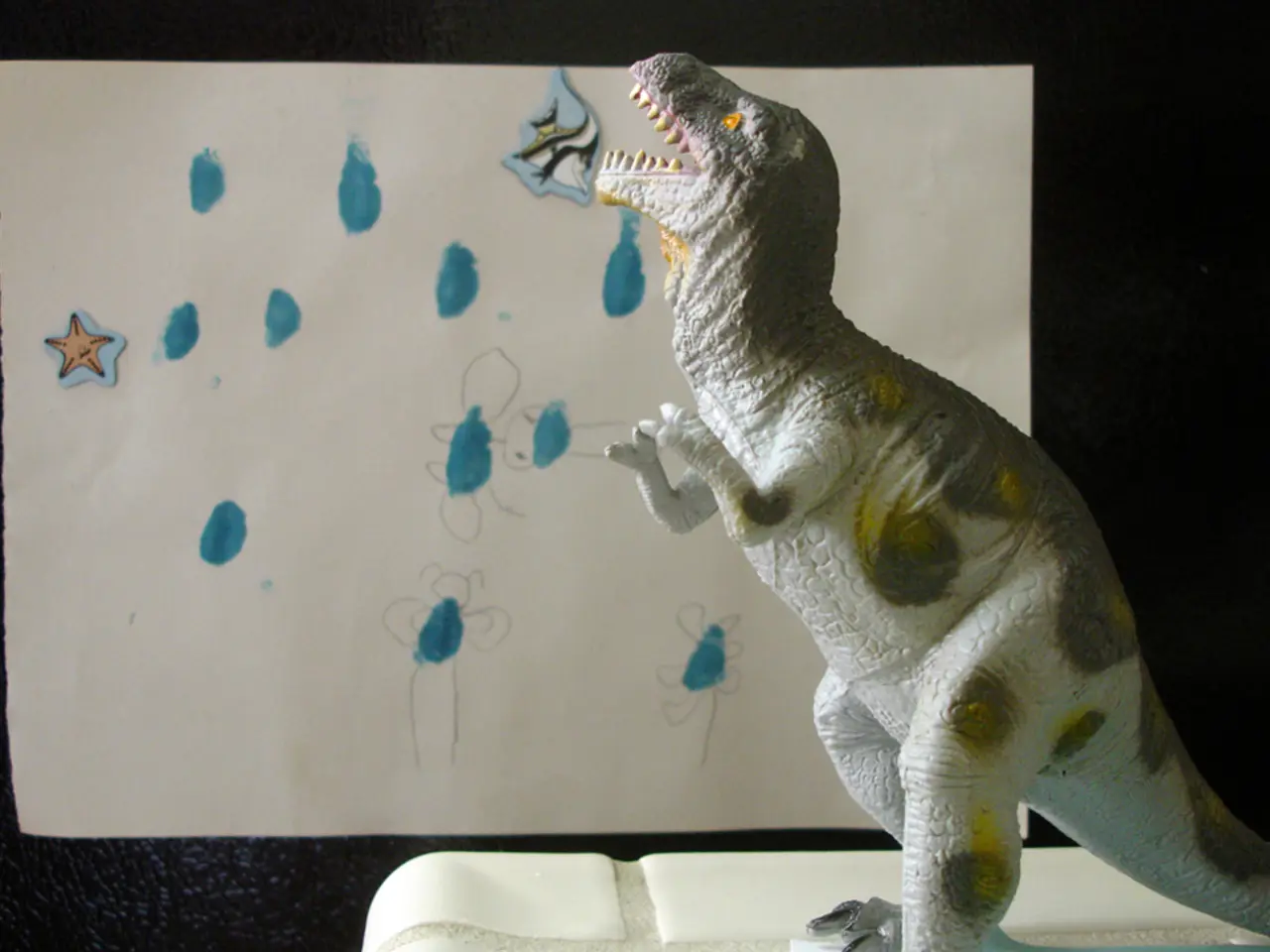Uncovered during post-flooding exploration in Texas: Ancient, 115-million-year-old dinosaur footprints, unearthed from buried fossils.
In Northwest Travis County, Texas, a remarkable discovery has been made: the unearthing of 15 well-preserved dinosaur footprints, dating back approximately 115 million years to the early Cretaceous period. These footprints, found in the Big Sandy Creek region and preserved in the Glen Rose Formation limestone, have provided new insights about the species that once roamed the area.
Key findings include the discovery of large, three-clawed prints, roughly 18 to 20 inches long, which indicate the presence of a bipedal carnivore approximately 35 feet in length. This size and the footprint layout suggest that the dinosaur may have been similar to the Acrocanthosaurus, the largest known predator in North America at that time.
The footprint layout also reveals a criss-cross pattern, suggesting that these theropods may have been moving in groups. This could provide clues about potential social or hunting behaviors.
Interestingly, alongside the carnivorous tracks, some footprints may belong to the Paluxysaurus, a large herbivorous sauropod and Texas’ official dinosaur. This dual discovery suggests that the area was a dynamic environment, home to a variety of dinosaur species.
The discovery was made by a group of volunteers working in the aftermath of the devastating July 2025 floods. The footprints were confirmed by paleontologists from the University of Texas, who plan to further study these tracks using mapping and 3D imaging to better understand the number of dinosaurs represented and the behaviors inferred from the footprint patterns.
The exact location of the site remains undisclosed to prevent unauthorized access and potential damage. Travis County Judge Andy Brown spoke to ABC News about the discovery, stating that it underscores the dynamic relationship between geology and paleontology, where natural events like floods can unexpectedly unveil long-buried evidence of the past.
This discovery has attracted significant scientific interest, offering insights into the behavior of large carnivorous and herbivorous dinosaurs. Paleontologists are focused on preserving the site, emphasizing the importance of protecting the fossils from further disturbance. Their goal is to create a more comprehensive understanding of the dinosaur tracks through further exploration and study.
References:
[1] ABC News (2025). Major Dinosaur Footprint Discovery in Texas. [online] Available at: https://abcnews.go.com/US/wireStory/dinosaur-footprint-discovery-texas-69894054
[2] University of Texas at Austin (2025). New Dinosaur Footprints Discovered in Travis County. [online] Available at: https://www.utexas.edu/news/2025/07/28/new-dinosaur-footprints-discovered-in-travis-county
[3] Brown, M. (2025). Preliminary Report on the Dinosaur Footprint Discovery in Travis County, Texas. [unpublished manuscript]
[4] Travis County (2025). Press Release: Dinosaur Footprints Discovered in Travis County. [online] Available at: https://www.traviscountytx.gov/news/2025/07/28/press-release-dinosaur-footprints-discovered-travis-county
[5] Paluxysaurus (n.d.) In: Encyclopedia of Paleoherpetology. [online] Available at: https://www.paleoherpetology.org/encyclopedia/paluxysaurus
- Science enthusiasts delved into the realm of environmental-science as they discovered the secrets of the past, uncovering 15 well-preserved dinosaur footprints in Texas' Big Sandy Creek region.
- In the realm of finance, the economic impact of the July 2025 floods may have unveiled hidden treasures, allowing for potential investments in education-and-self-development within the field of paleontology.
- The space-and-astronomy community can draw parallels from this discovery, learning that natural events like the flood could metaphorically represent space debris unveiling long-buried secrets.
- As for lifestyle, this discovery adds a touch of dinosaur charm to food-and-drink culture, with local cafes and bars potentially incorporating dinosaur-themed menus or decor.
- Shopping malls and casinos in home-and-garden regions might take inspiration from this event, introducing dinosaur-themed rides and attractions to boost visitors' interest.
- In the sphere of personal-finance, individuals might consider investing in artifacts, as the high demand for dinosaur fossils indicates a growing and lucrative market.
- Businesses in the field of technology could capitalize on this discovery, developing virtual and augmented reality experiences that let guests walk amongst the footprints and bring the dinosaur's presence to life.
- The travel industry might see a surge of tourists seeking to explore the newly discovered dinosaur grounds, sparking an interest in domestic tourism alongside international travel destinations.
- In relationships, conversations may organically shift to compare the dynamics between these prehistoric dinosaurs and modern human relationships, delving into topics of social behavior, hierarchy, and coexistence.




